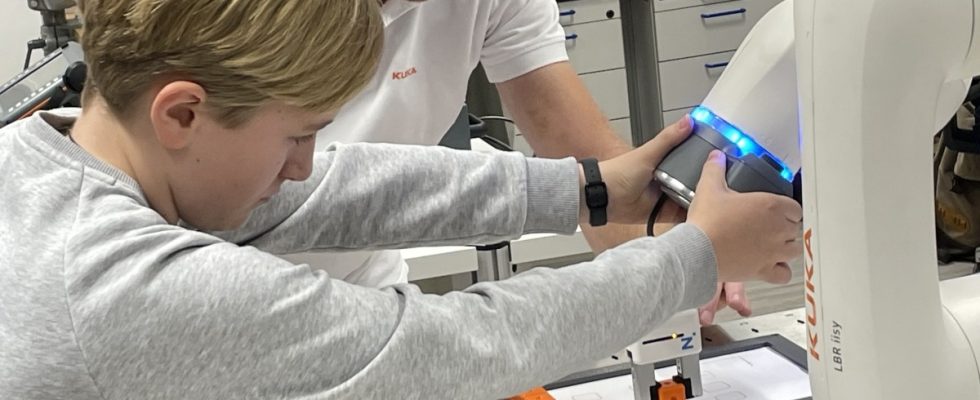Michael Hertle has been waiting for this moment. The 13-year-old carefully grabs Iisy’s arm with both hands and moves his gripper across a field with printed square boxes. His goal: an orange cube in the middle. He places the gripper on the cube, pauses briefly and saves the position on the smartpad. Here Hertle can choose from a variety of commands, for example whether the gripper should grab and move up, move to the side or let go. The 13-year-old repeats these steps several times, always repositioning the cube. At the end, Iisy can pick up the cube independently and place it in a desired position. And all automatically.
“This is a very simple way to program a robot,” explains Frank Zimmermann from the corporate development department at robot manufacturer Kuka. The group has around 15,000 employees worldwide, including 3,500 in Augsburg.
The group has developed LBR Iisy, this so-called collaborative robot, or cobot for short. This means: a sensitive robot with which people can work together safely and which can be controlled by anyone thanks to its intuitive operation. Kuka is considered one of the first companies in the world to develop cobots.
These sensitive machines are now used in industry, for example. Here, among other things, they support their human colleagues in monotonous or physically demanding work.
This Iisy model is in the Kuka training center and has a special task on this day: The cobot is supposed to show young people how exciting robotics can be. To this end, the company invited other students alongside Michael Hertle to mark the European Robot Week.
“At first the young people are always cautious, but once the ice is broken, curiosity is aroused,” says Frank Zimmermann, who is currently showing another group of young people not only the theory but also the practice. None of those present need be afraid of contact, after all, Iisy is prepared for exactly that. “Cobots stop when people get too close to them,” explains Zimmermann. The torque sensors on all six axes allow the cobot to detect early if it hits an obstacle, such as a little finger.
“I have a Lego robot at home”
Some of the young people have even had experience with robots. “I have a Lego robot at home,” says Michael Hertle as he maneuvers Iisy’s arm towards the cube. Later he will say it felt like a computer game.
Not everyone was as enthusiastic as Michael Hertle when the first robots were used in industry in the 1950s. “For a long time there was a great fear that jobs would be at risk,” says Kuka’s deputy spokeswoman, Teresa Fischer. This is often due to the fact that ideas about robots are often associated with science fiction stories. Although they have little in common with robots such as those used by automobile manufacturers, skepticism about this technology remains persistent. This is another reason why education about robots is important to the company. After all, these have long been part of our everyday lives.
Colleague Cobot: Robots stack beer crates in a brewery in the Erzgebirge.
(Photo: KUKA Group)
In the supermarket, in medicine, at the physiotherapist, behind the bar and now also in the trades, robots and cobots are used. “The strengths of robotics and automation lie in strength, endurance and repeatability,” says Fischer. Medium-sized companies are increasingly taking advantage of this. Be it a master carpenter who wants to avoid the strenuous task of carrying wood or a brewery in the Erzgebirge that has beer crates stacked.
Some even see this technology as an opportunity to counteract the serious shortage of skilled workers. “Robotics and automation will be used in more and more areas in the future,” says Fischer.
For Kuka, exchanging ideas with young people is important, not least when looking for future employees. Because after personal contact at trade fairs, through internships or events was largely eliminated, especially in the wake of the Corona pandemic, the number of applicants fell briefly. “Such personal insights are incredibly important to us,” says the head of the training center at Kuka, Manfred Schussmann. After all, no flyer could catch that.
Manfred Schussmann knows that the framework conditions must be right so that young people not only decide on robotics, but also possibly on an apprenticeship at Kuka. The company is therefore keen to constantly improve. Just like their cobots: The models in the Iisy series are therefore also available with extended load capacities and greater ranges.

